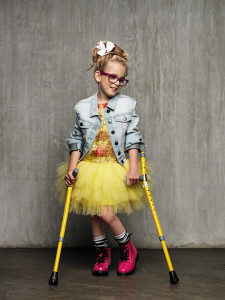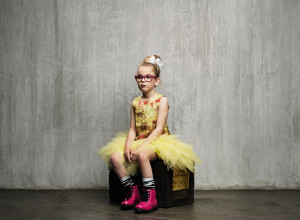A few days ago it was the International Day of the Girl Child and social media joined in the discussion about the importance of education and empowerment for girls. It was a day for standing up for the rights of young girls and to recognise their voice and their capacity to change our world for the better.
One young girl who is doing just that is Emily Prior, an eight year-old from Perth, Western Australia, who has cerebral palsy and is challenging the advertising industry to include people with disability, by forging a path as a model – on her terms.
Earlier this year, Emily, who describes herself as “funny, kind, determined and independent”, was looking through a catalogue with her mum, Jen, when she asked “Mummy, why are none of the models in here disabled like me?”
Although in recent years an increasing number of brands have begun to include people with disability into their core messages and campaigns, the statistics are practically irrelevant when a perceptive 8-year-old girl still knows that, for the most part, people like her are left out of the picture.
Emily had previously been featured in disability-related marketing but what she really wanted to know was why she couldn’t see any girls like her in mainstream advertising.
It’s an important question. We see ads every day – on our social media, favourite blog, a web page, before a movie or during our favourite TV show – and they are designed to impact our perception of the world around us. And it is undeniable that they do – advertising is fundamentally about communication and persuasion and if it wasn’t able to do that, it wouldn’t be a multi-billion-dollar world-wide industry.
But for a long time, advertising has represented our society based on a narrow aesthetic for people that has excluded so many of us, notably, anyone with a disability or “difference”.
There are different theories about the reasons for that but what’s important is that in recent times a grass-roots movement towards greater diversity – including disability – in advertising has gained momentum. Why? Maybe we’ve begun to realize that advertising’s narrow aesthetic doesn’t actually make us feel good – it’s creating resentment by bombarding us with unrealistic images. Or it could be that our exposure to a more “real” aesthetic, through the effects of social media and people taking pictures of themselves and of their real lives, has begun to change our expectations about the imagery we see. For people with disability, the demand to be seen in advertising is particularly significant – it is part of a broader challenge, in response to a long history of excluding people with disability from society, by increasingly occupying places in the public eye.
Social media has indeed provided an opportunity for people who have been unrepresented (or misrepresented) in traditional media, to take the reins of their own images and project themselves on their own terms.
And Emily is doing just that. Although she signed up with a model agency earlier this year, her mum suspects that attitudes to disability in that industry have been a barrier so the resourceful team decided to create their own opportunities using social media. It is there that Emily has become a rising star, modelling her own fun take on clothes and accessories – she coordinates her many eye wear frames which she has in blue, purple, pink, red and tortoise shell with funky outfits and her bright yellow “sticks” – the mobility aids that Emily uses to get around.
Emily recently caught the eye of Target which agreed to lend her some clothes for her photo shoot last month with Stefan Gosatti, a fashion photographer who is keen to support Emily’s mission and aspirations.
At Starting With Julius we also got behind Emily and her determination to challenge attitudes through advertising and claim her right to participate and be included. Recently, we were able to connect Emily with a high profile children’s fashion brand after one of the owners contacted us to express support for our mission. Later this year Emily will shoot her first ever mainstream advertising campaign, with them.
Last week I was delighted to be able to interview Emily and to find out a little bit more about how she sees herself and the world. She is fiercely independent but appreciative of help when she needs it. She is also kind and considerate of her family and friends. Most of all, she is proud of who she is and committed to making the world a better place that accepts each of us for who we are. Here is what Emily had to say, in her own words.
Catia: What is your favourite school subject – and why?
Emily: “I like Art – it’s fun to make things. I enjoy painting and drawing”
Catia: What do you like to do for fun – and why?
Emily: “I like lots of things. I like playing with friends, riding my bike, swimming, drawing, singing and having sleep overs!”
Catia: If you could have a playdate with a book or movie character, who would it be – and why?
Emily: “I would like to play with Roald Dahl. I like his books and have been learning about them at school”
Catia: If you could be any animal, which one would you be – and why?
Emily: “I would like to be a puppy dog. You get to sleep inside and wear cute doggy jackets!”
 Catia: I know you would like to be in some fashion advertisements and magazines. Why is that important to you?
Catia: I know you would like to be in some fashion advertisements and magazines. Why is that important to you?
Emily: It’s important because it’s who we are. We have disabilities and you can learn more about disabilities when you see them.
Catia: What do you think is the best part of being a kid?
Emily: “You get to have fun, play with your friends and family”.
Catia: What would you like other people to understand about having a disability?
Emily: “That you can do anything if you try hard enough. Sometimes you have to do it differently but you can still do it”.
Catia: What makes you happy?
Emily: “That I can do things by myself. I’m proud that I always try my best.”
Catia: What would you change about the world – and why?
Emily: “That people are kinder to everyone and are friends.”
Catia: What things should adults learn from kids?
Emily: “That kids can do things by themselves and don’t need help all the time.”
Catia: You have 1 sister and 2 brothers – what do you love most about them?
Emily: “They are kind to me and they always stick up for me. I always have someone to play with.”
Catia: What was the nicest thing you did for someone?
Emily: “I am kind to people. I have a friend who has autism and I always help him when it is hard for him.”
Catia: What was the nicest thing someone did for you?
Emily: “People do lots of kind things for me. They are helpful when I need help.”
Catia: When you are 10 years older than now, what would you like to be doing?
Emily: “I think I will be studying at university. I would like to work with animals and still be a model. I would like to be helping people with disabilities.”
[Photos © Stefan Gosatti]
Thank you for visiting our website. You can also keep up with our mission for #adinclusion by liking our Facebook page or following us on Twitter @StartingWJulius




